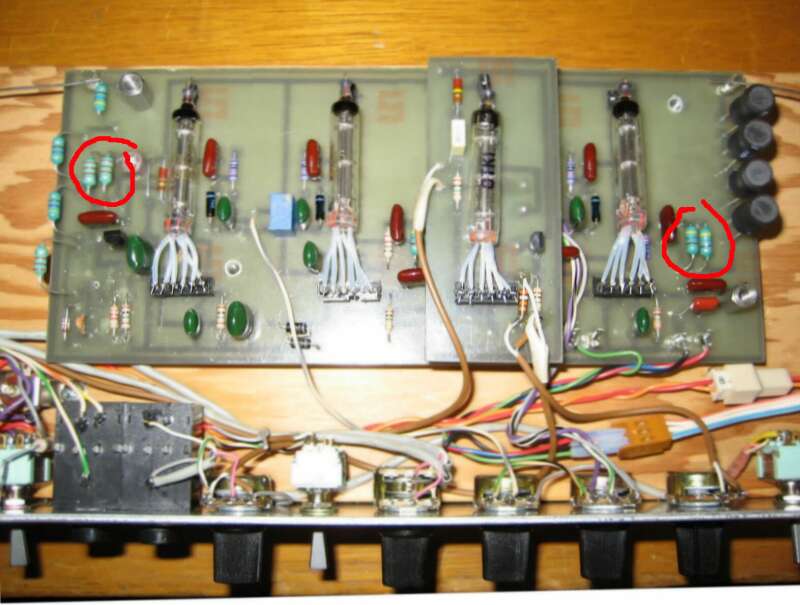yes, EWS=Etherwave Standard"But, I suppose I could do a digital control with a mux or relays..." - CharmQuarkIMO an unjustified overcomplication.The tuning is required only once, after assembling (well maybe several times after falling to the floor)."can be replaced by a bank of capacitors 1-128p" - CharmQuarkthat was just a concept.The EWS inductors have a trimming range about +-25%. If we replace it by fixed inductor plus trimming capacitor, the capacitor range should be also +-25%.Back to EWS:The new value of C1 have to be 2475 pF plus trimming capacitor 0...1650 pF in parallel (unrealistic!).So the bank must include values: 1650/2, 1650/4, 1650/8 pF and so on.What is the lower limit?IMO about 12...25 pF, as the fine tuning of EWS ("Pitch" knob) has a capacitance equivalent of 50 pF (very approximately).As a result, 7 of standard caps: 820, 430, 220, 110, 51, 27, 13 pF.
Well, this over-complication were just to mitigate what you thought could be hard for the user, but if it only is trimming once, and perhaps not even by the user, then I don't really see the problem with log2-switchbank (but incidentally, I found that I have a hundred 0-F encoders with binary output just lying here, in a footprint like a large trimmer pot, so that one was easy if it should be on topic!  ).
).
But the main point is: do you say that the EWS trimmer inductor(s) can be replaced trimming the caps in the tank? (I mean, of course they can, but does it work in practice?). I mean, the same thing goes here as the "replacing oscillators" idea. For some reason no one seems to have done it, and the only reasonable interpretation I can do is that it won't work and/or have side effects making it not worth it. On paper it should work.
As I said before, the schematic I posted were cut-and-paste basically, I have *not* recalculated values for any of the components. I also see the mismatch between the antenna coils (according to EWS) and L5. But I have kind of leaved that project altogether, and currently work just with your own "Paradox" that I think is very promising. My idea is to replace the pitch oscillators to be less trimmer inductor and trimmer cap-heavy so to speak and replacing the obsolete AN5265 with another amp. No other modification other than maybe footprints (I work mainly with 0603 for non-power passives).
I haven't solved the volume tuning yet. I would like to replace the large 3.3µH (L3) and your custom C12 with something easier to source. But for the time being I keep this part and just have to source/build the components.
The most important question I have about the design right now, is how much trimming needs to be done on a regular basis? You have the custom caps connected to the front with knobs. Does that mean they are used in such a way that using small trimmer caps would be an inconvenience. I'm focusing on the volume turning circuit.
@dewster: When I said I'm having proximity to metals (both grounded and floating) I really meant it. I'm almost in a cage and less than a foot away is a large grounded metal case, less than two feet to my right, the same thing. Below, on the desk I have a ESD mat that can be hard to predict thanks to the very large resistance. Two ungrounded metal locker sits about two foots downward, left and right and just a few inches above my head I have a old fluorescent lamp. And SMPS everywhere, some open without shield (but with a little more distance, they should be less of a problem). Normally its no problem at all, rather something that forces me to thing about EMC when doing sensitive stuff. I'm picking up 50 and 100 Hz, ~1 kHz (no idea), a few spikes at several hundreds of kHz (SMPS of some flavor) and have kind of a high noise floor. If I move to the living room, the antenna (just a vertical cable at this point) actually seems to work much better.
Right now I'm reading your thread "Let's Design and Build a (simple) Analog Theremin!" from end to end and testing your oscillators in spice. They are promising and the frequency ranges seems just what I need! 
I'm not against digital but for example the "OpenTheremin" doesn't have decent and honest sound samples, not what I have found anyway and I'm not in a mood to starting a whole project for that, with software and whatnot. I'm looking more for something I can test, cad and build in a short time. And I have already a ton of embedded digital projects going on that I need some "vacation" from.
@Thierry: Yep, I kind of guessed that. There is a dozen theremin designs for each honest sound sample out there. The EWS, the Phoneix and the Paradox all has the advantage that you can listen to them on the net.



